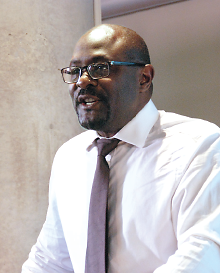Psychiatrists Want to Do More for Toronto’s Growing Immigrant Population
Abstract
Even when immigrants report mental health issues, many may have a tough time accessing culturally competent mental health care.
The health equity of diverse populations is no trivial matter, said Kwame McKenzie, M.D., in a talk on immigrant mental health, sponsored by APA’s Division of Diversity and Health Equity. The event took place during APA’s 2015 annual meeting in Toronto.

Patients, families, and clinicians in Ontario must unite to build momentum for change in the province’s mental health system, says Kwame McKenzie, M.D., a professor of psychiatry at the University of Toronto.
“Diversity is everybody’s business, and if we forget that, we will not be treating everyone as well as we can,” said McKenzie, a professor of psychiatry at the University of Toronto and CEO of the Wellesley Institute, a Canadian social policy think tank.
Toronto is a very diverse city and is getting more so all the time, he said. About 80 percent of its new immigrants come from South or East Asia, and even immigrants from Europe come from numerous countries.
Just collecting data on immigrant mental health can be challenging, said Branka Agic, M.D., Ph.D., manager of health equity at the Centre for Addiction and Mental Health in Toronto. For example, a survey of new immigrants in Ontario reported lower rates of alcohol use and alcohol-related problems than the Canadian-born population, a finding that Agic said comports with the common wisdom.
However, she added, a variety of reasons might explain why immigrants, particularly those who are young, may choose not to disclose drinking habits: some fear that their immigration status will be compromised if they reveal their alcohol use; others come from cultures that stigmatize alcohol problems.
As a result, there is a need for culturally and linguistically relevant research designed to accurately monitor alcohol use, Agic said.
Many immigrants may also face cultural barriers to finding help, said social worker Baldev Mutta, CEO of the Punjabi Community Services in Brampton, Ontario.
“They don’t understand psychiatric terms or the scientific origins of mental illness,” said Mutta. “They also don’t understand the treatment system, like the difference between medication and talk therapy.”
They may bring with them alternative concepts of disease, he said. Traditional Indian Ayurveda medicine is based on ideas of “hot” and “cold,” for instance. But ice is “hot” and so is all Western medicine, making the latter difficult to accept. The solution, said Mutta: “We bring in the whole family, educate them, and develop two care plans, one for the client and one for the family.”
Another outreach approach offered to immigrants in Toronto is the Assertive Community Treatment (ACT) team, located in Toronto’s Chinatown, said Lisa Andermann, M.D., M.Phil., an associate professor at the University of Toronto and a staff psychiatrist at Mount Sinai Hospital. The team is based at Mount Sinai and offers customized community-based services for people living with serious mental illness, mostly from Asian countries.
“This was the only ACT team set up from the beginning with a culturally diverse approach,” said Andermann. “We hired clinicians to reflect the populations they serve, creating a ‘hospital without walls’ in a neighborhood with many immigrants.”
Teams include social workers, nurses, occupational therapists, and medical students, as well as a psychiatrist, she said. About half their patient population is Chinese; a quarter is Tamil, and the rest Korean, Vietnamese, Caribbean, or African. Most are diagnosed with schizophrenia, schizoaffective disorder, or bipolar disorder.
In its first year of operation, the team managed to reduce hospital stays from an average of 97 days before intervention to 21 days afterward, she said. Using ACT saved money and kept patients in the community.
Even as Canada becomes more diverse, there remains no overall plan for improving the health of this new population, said McKenzie. Identification of mental health needs and early access to treatment are currently underused, he said.
“We know how to improve mental health for diverse populations; we know how to structure systems and when and how to adapt interventions,” he said. “The problem is that when we don’t do these things, we have to deal with them downstream. We should move upstream and decrease the pipeline of people coming in for services.”
However, ramping up cultural competence is no simple matter.
“One problem with cultural competence training is that only the frontline staff attends,” said Mutta. “The CEOs and board members should go, too, because we need to change the system, not just blame and train the staff.” ■



